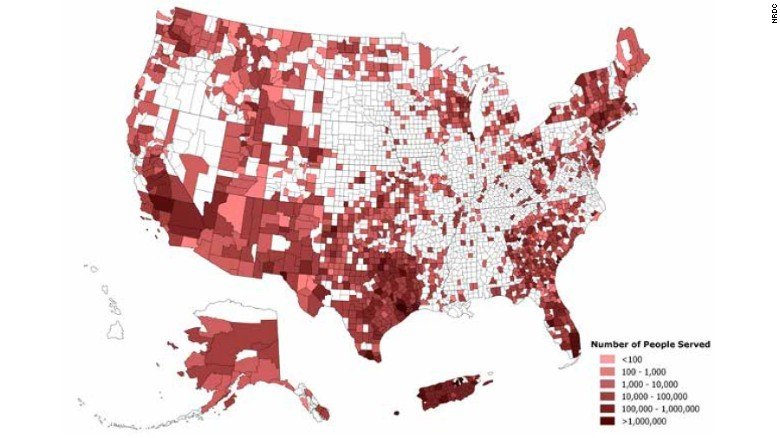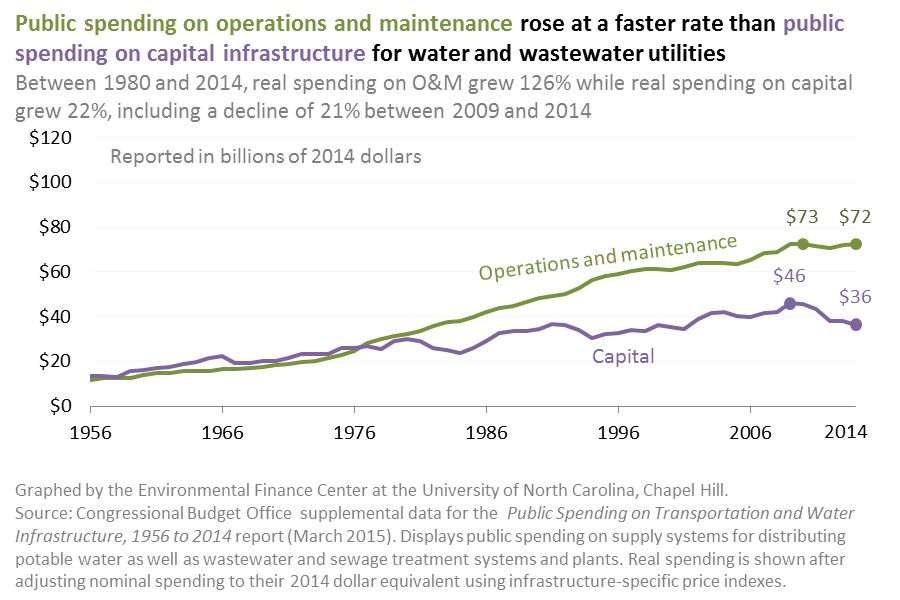Connected sensors for water quality testing

With spending on water infrastructure decreasing, sensors can help consumers and utilities diagnose problems sooner.
What’s in your water? In Flint, Michigan, a 2014 water-supply switch from Detroit’s Lake Huron system to the Flint River led to concentrations of lead significantly exceeding the maximum acceptable levels.[1] Earlier this year, CNN reported that over 5,300 water systems in the US were in violation of the EPA’s lead and copper regulations, which were designed to protect Americans’ drinking water. As the graphic below shows, there are nearly 18 million people who, as of 2015, were being served by community water systems with reported violations of the lead and copper regulations.[2]
In many of these locations, water infrastructure is outdated, leading to higher-than-acceptable levels of contaminants in drinking water. Unfortunately, as University of North Carolina’s Environmental Finance Center points out, spending on capital infrastructure for water utilities has not kept pace with operations and maintenance spending, and “as state and local governments’ budgets are spread thinner by paying for rising operations and maintenance, their ability to also pay for capital expenses decreases.”[3] Thus, we end up in situations such as Flint, Michigan, where a cost-cutting measure leads to poor social outcomes.
While sensors themselves are not the answer to suboptimal infrastructure spending or replacement for EPA monitoring of water quality, they may increase transparency and decrease data collection costs so that citizens are aware of what’s in their water, and so that local, state, and national governments can respond quickly once problems are detected.
NanoAffix Science
Researchers at University of Wisconsin-Milwaukee began the development of water quality sensors, and formed NanoAffix Science to commercialize the technology.
Based on an email exchange with Junhong Chen, inventor of the technology and founder of NanoAffix, the company is developing and prototyping two types of low-cost sensors that can test tested for heavy metals, bacteria, and/or nutrients: One, a hand-held device for one-off water quality testing, and two, continuous monitoring sensors that can operate while submerged.
Initially, NanoAffix’s sensors will enable rapid, high-precision, low-cost testing for lead via the handheld device. The next step is continuous testing: NanoAffix’s sensors will enable water utilities to track real-time data on water quality throughout their systems relatively affordably, and pass their data through to regulatory agencies.
Investing in a path to commercialization
At least three companies have invested in NanoAffix’s sensor technology to enhance their value propositions to customers:
- A.O. Smith is currently focusing on applying the technology to the home filtration systems it manufactures in, and for, the Chinese market.
- Badger Meter, on the other hand, manufactures water meters and is considering installing water-quality sensors within its meters.
- Baker Manufacturing produces pumps and water filtration systems, and may apply these sensors to pumps for private wells.[4]
A business model for Badger Meter could be to sell both the hardware (sensors) and the software (data tracking platform, layered-on data analytics) to municipal water utilities. Spending on distributed, continuous testing should enable these utilities to isolate problems – for example, if copper is only in the pipes of a certain neighborhood – and to identify them earlier, driving cost savings through early response.
While the current and in-development applications represent sizable market opportunities, they largely focus on B2B segments or niche B2C. Significant mainstream B2C business model applications may also exist, and should be considered.
Opportunity 1: Consumer-facing water quality sensor
Currently, consumers have two options if they want to test their water at home: Purchase one-time-use water testing kits from Amazon which require them to color-match[5] or find a certified water-testing laboratory that will accept private residence samples (few in Massachusetts do).[6] The former is unreliable; the latter is expensive, complicated, and time-consuming.
Nanoaffix’s in-development continuous monitoring technology could result in a product that addresses these challenges. Eventually, a sensor could be placed in a faucet, providing real-time information to the user (via an app).
This would enable an exciting business model. The product could be sold as an annual subscription including both the price of replacement sensors and access to the app. In addition, the data collected could be sold to local water utilities, giving them access to water quality at the home-level without requiring them to spend their limited funds on a massive fleet of sensors.
Opportunity 2: Consumer filter quality sensors
From refrigerator-based water filters to Brita filters, the use of microfluidic water quality sensors could increase the frequency of filter replacement, enhance the ease of reordering (e.g., via the monitoring app), and increase customer satisfaction with the filters they’re using. Currently, consumers may not know whether the filters they’re using are effective; they certainly are unaware of the quality of their water at any one point in time. NanoAffix’s technology could thus be integrated into existing products, providing additional value to both consumers and producers.
(Word count: 789)
[1] New York Times Flint timeline
[2] CNN article on lead in water systems
[3] Shadi Eskaf, Senior Project Director of University of North Carolina Environmental Finance Center, article: “Four Trends in Government Spending on Water and Wastewater Utilities Since 1956”
[4] Milwaukee Journal-Sentinel: “Clean Water Crisis Spawns UWM Research into Water-Monitoring Products”





Great post, Rob. Besides the greater public good implications of this technology, I really liked the auto-monitoring Brita filter idea.
In your research, were you able to find any data on the expected price of these sensors? Widespread success of these sensors definitely depends on being able to offer them at a relatively low price (particularly for disposable applications like Brita filters). Do you have any feel for how close this technology is to being mass produced and widely available?
Great post, Rob! This technology seems really cool. The main thing I’m worried about is that the most disadvantaged households will not really have access to either the product or to remedies for poor water quality. In Flint, for example, it was households that weren’t using water filtration that were most affected, and only with significant public outrage were things actually done to improve quality (despite having super visible evidence of the contamination). It’s unclear whether disadvantaged communities in other locations would have access to either the technology or the relevant information, and if they did, what they would be able to do to improve quality. Have you thought about whether there might be some sort of market for nonprofits focused on environmental/water quality, who might have the resources and the clout to make an impact? Not really sure how that would work, but just a thought.
Thanks for the interesting post, Rob! Given its necessity for sustaining life, any technology that can effectively improve access to safe drinking water is worthwhile. This application is interesting because of the control that it gives to end-consumer and certainly makes sense from a value purchased vs. value consumed perspective. But is the end-consumer the right target customer? Perhaps, as Ben suggested, nonprofits interested in this area or government agencies responsible for clean water might be more appropriate. If consumers cannot afford the product, to which both Alex and Ben have alluded, their natural response will be to call for such technology at the local municipality level who has the ultimate responsibility for providing safe water. Regardless of these concerns, technologies like this will certainly continue to change the business models of companies engaged in water treatment, testing, and distribution. Given the additional transparency provided by this technology, business models may be modified in the future to better match pay with performance which may help mitigate issues like we saw in Flint.
Hi Rob – thank you for sharing this article with us. It’s scary to internalize the first graph you posted. I’m in shock that ~18 million people in the US were served water with unacceptable traces of lead and copper. I can definitely see how NanoAffix can add value by detecting water impurity from the source. My question is, even if local and state government installed NanoAfflix, will that be enough to incentivize them to invest in water infrastructure? There is still a gap between knowing the problem and doing something about it. I also agree with the folks above re: whether B2C is the right strategy, since it seems like water, as a public utility should be “fixed” from the source.